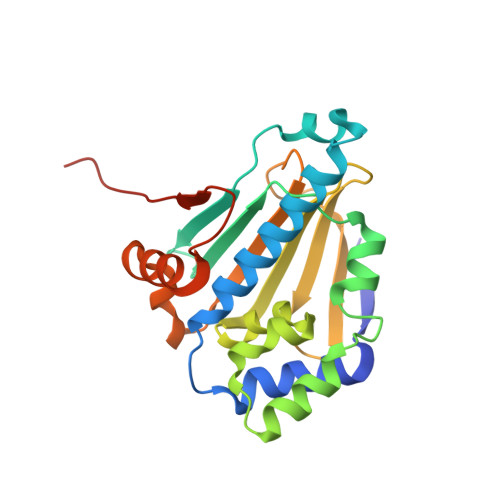Structural Basis of the Radicicol Resistance Displayed by a Fungal Hsp90
Prodromou, C., Nuttall, J.M., Millson, S.H., Roe, S.M., Sim, T.S., Tan, D., Workman, P., Pearl, L.H., Piper, P.W.(2009) ACS Chem Biol 4: 289
- PubMed: 19236053
- DOI: https://doi.org/10.1021/cb9000316
- Primary Citation of Related Structures:
2WEP, 2WEQ, 2WER - PubMed Abstract:
Heat shock protein 90 (Hsp90) is a promising cancer drug target, as multiple oncogenic proteins are destabilized simultaneously when it loses its activity in tumor cells. Highly selective Hsp90 inhibitors, including the natural antibiotics geldanamycin (GdA) and radicicol (RAD), inactivate this essential molecular chaperone by occupying its nucleotide binding site. Often cancer drug therapy is compromised by the development of resistance, but a resistance to these Hsp90 inhibitors should not arise readily by mutation of those amino acids within Hsp90 that facilitate inhibitor binding, as these are required for the essential ATP binding/ATPase steps of the chaperone cycle and are tightly conserved. Despite this, the Hsp90 of a RAD-producing fungus is shown to possess an unusually low binding affinity for RAD but not GdA. Within its nucleotide binding site a normally conserved leucine is replaced by isoleucine, though the chaperone ATPase activity is not severely affected. Inserted into the Hsp90 of yeast, this conservative leucine to isoleucine substitution recreated this lowered affinity for RAD in vitro. It also generated a substantially enhanced resistance to RAD in vivo. Co-crystal structures reveal that the change to isoleucine is associated with a localized increase in the hydration of an Hsp90-bound RAD but not GdA. To the best of our knowledge, this is the first demonstration that it is possible for Hsp90 inhibitor resistance to arise by subtle alteration to the structure of Hsp90 itself.
Organizational Affiliation:
Section of Structural Biology, The Institute of Cancer Research, Chester Beatty Laboratories, 237 Fulham Road, London, U.K.
















